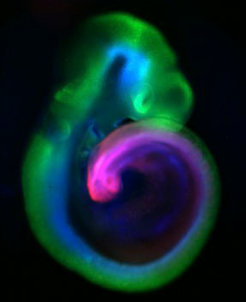Emeritus Group Developmental Genetics

Understanding mammalian development requires deciphering the mechanisms by which stem cells give rise to various cell lineages, and how they organize into functional 3-dimensional structures and organs. This is an immensely complex process requiring thousands of protein-coding as well as non-coding genes, which change activity from cell type to cell type. Since Brachyury (T) is one of a small set of key control factors (together with Sox2, Foxa2) essential for trunk and tail development, a major focus of our work is concerned with the role of T in relation to these factors in shaping the embryonic trunk and tail. Bodies are formed from billions of cells, and therefore understanding development comprises unraveling gene regulation mechanisms at the single cell level and deciphering the self-organization of cells taking different fates in response to signals secreted from their neighbors, thereby forming a functional assembly of organs and tissues.
Another research focus in the department is the question if non-mendelian inheritance is the result of singular evolutionary process that gave rise to the t-haplotype, a chromosomal variant in mice transmitted at high ratio from heterozygous males to their offspring, or a more general phenomenon, which has remained undiscovered up until now in mammals.











